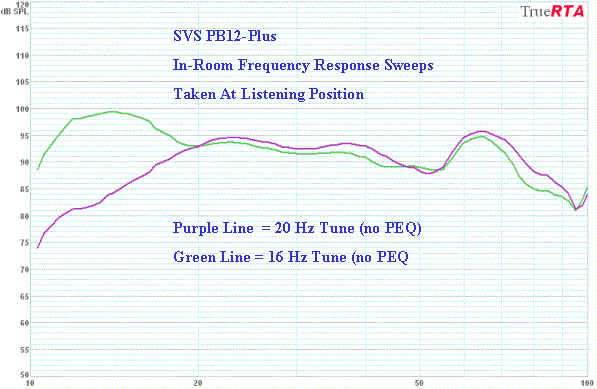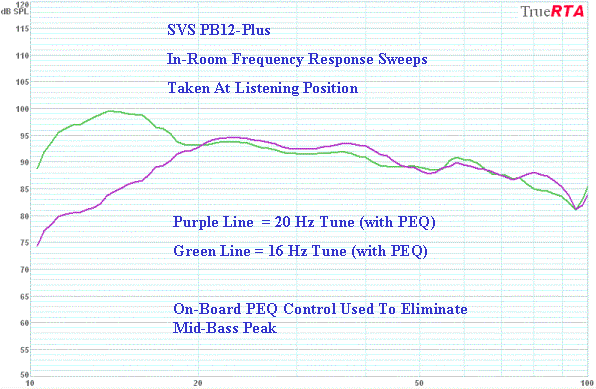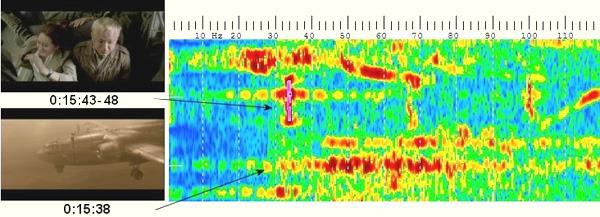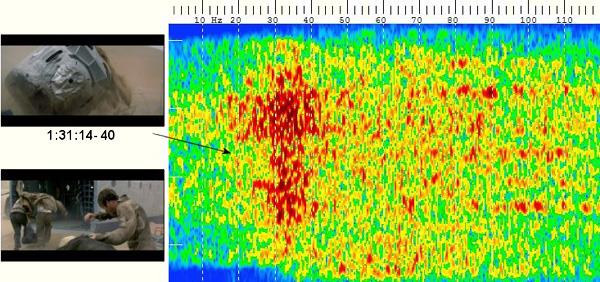In-Room Frequency Response
I placed the PB12-Plus in the front left corner of my 2,000 ft3 evaluation
room, which is acoustically treated and bass-trapped. I connected the
software signal generator to an analog stereo input on the pre-pro and
measured the combined frequency response of the mains speakers and subwoofer
at the primary listening position.
For digital bass management, the main speakers were set to Small with a
crossover frequency of 80 Hz. The digital bass management circuit imposes a
2nd order high pass filter on the speakers, and a 4th order low pass filter
on the subwoofer. Accordingly, I set the PB12-Plus low pass filter to
Disable. While phasing the mains and the subwoofer, I obtained the best
results with the PB12-Plus phase control set to about 45 degrees.
The in-room frequency response showed a peak in the 60 Hz - 70 Hz region (likely
resulting from using full range mains with a 2nd order high pass), but
otherwise looked smooth and linear. As shown in the graphs below, I used the
on-board PEQ feature on the PB12-Plus to eliminate this mid-bass peak and
provide a smooth transition between the mains and the subwoofer.
My evaluation room provides some room gain below about 30 Hz, and this gave
both tunes a mildly rising in-room response at the very deepest frequencies.
Since the human ear grows progressively less sensitive to deeper
frequencies, many people will subjectively perceive this type of frequency
response as even sounding across the entire bass spectrum. Regardless, after
PEQ optimization, both the 20 Hz and the 16 Hz tunes posted enviable in-room
frequency response curves, with the 16 Hz tune extending to about 12 Hz.


With Movies
I played several action-oriented DVDs, evaluating the PB12-Plus for mid-bass
dynamics, audible artifacts (muddiness, cone cry, rattling), deep extension
and output compression.
To determine the maximum playback level, I increased the master volume until
the subwoofer started to exhibit audible distress, compression, or loss of
deep extension on the most demanding deep passages. I then backed off the
master volume until the subwoofer again sounded clean, dynamic, and deep. At
this master volume setting, I monitored the sound pressure levels at the
listening position with a B&K sound level meter set to C-weighted fast. The
SPL peaks listed are straight meter readings, with no correction factors
added.
Given the results I obtained in the objective testing, it came as no
surprise that the PB12-Plus is a real powerhouse for HT applications. In the
20 Hz tune, sound pressure peaks of 112 dB - 114 dB (C-weighted Fast) were
definitely within the audibly clean and uncompressed limits of the
PB12-Plus, which is very impressive for a single 12” driver subwoofer. In
the 16 Hz tune, I was able to coax about 108-110 dB (C-weighted Fast) peaks
from PB12-Plus before I heard audible distress, which is still an excellent
performance, and enough for all but the most ardent bass heads.
Subjectively, the 20 Hz tune feels the most muscular, while the 16 Hz tune
is a bit more restrained. Since I place a priority on output dynamics and a
lack of compression, my personal preference for HT applications was the 20
Hz tune. However, another enthusiast might prefer a lower play back level
and place a higher priority on ultra deep extension, and therefore might opt
for the 16 Hz tune instead.
My overall subjective home theater ratings for the PB12-Plus are provided in
the table below, with a rating of 5 being the best score:
|
Evaluation
Criteria |
20 Hz Tune
Rating
(1-5) |
16 Hz Tune
Rating (1-5) |
Summary Comments |
| Mid-Bass Dynamics |
4.75 |
4.25 |
Very good mid-bass output in either tune, with
the 20 Hz tune being noticeably stronger. |
| Audible Artifacts |
4.75 |
4.25 |
It’s difficult to drive the 20 Hz tune into
audible distress. The 16 Hz tune can be driven into minor audible distress
at very high volumes. |
| Deep Extension |
4.50 |
5.00 |
Deep extension is excellent in both tunes, with the
16 Hz tune digging extremely deep. |
| Deep-Bass Compression |
5.00 |
4.50 |
Both tunes are very resistant to deep bass
compression. The 20 Hz tune exhibits virtually no deep bass compression near
its limits. The 16 Hz tune can be driven into minor deep bass compression at
very high volumes. |

Provided below are my listening notes (PB12-Plus in the 20 Hz tune) and a
few spectral frequency charts, from Flight Of The Phoenix in Dolby Digital
5.1. These spectral color charts were electronically recorded directly from
the DVD, and show where the deep bass occurs on a given passage, with dark
red and pink colors being the highest amplitude. As shown in the spectral
charts, many of the strong bass scenes in Flight Of The Phoenix have strong
content in the 20-40 Hz region. These spectral charts were provided courtesy
of Ilkka Rissanen.
Storm Turbulence (0:13:52-56); 108-111 dB
The PB12-Plus feels very muscular on this scene, easily pressurizing the
evaluation room and realistically creating the sensation of plane buffeting.

Plane Sweeps Past (0:15:38); 114 dB
Talk about mid-bass dynamics – this scene is loaded with hot bass in the
40 Hz - 70 Hz region and is very short in duration. The PB12-Plus punched the
room hard on this scene, doing a great job of convincing the viewer a huge
plane just blew past.
Plane Rolls Upside Down (15:43-48); 109 dB - 110 dB (sustained)
This scene has the viewer gripping the arm chairs as the plane rolls upside
down. This sound effect contains a very high amplitude signal at 35 Hz which
last for about 5 seconds. The PB12-Plus held strong and sounded clean,
dishing out a steady 109 dB - 110 dB with no signs of compression.

Phoenix Is Buried In Sand Storm (1:31:14-40); 108-110 dB
Here the Phoenix is buried in a wicked sand storm and we fear all may be
lost. The storm builds in power and intensity toward the end of the scene,
and the PB12-Plus shows off its deep extension capability, cleanly capturing
all of the 18 Hz - 22 Hz underpinnings that make this passage so gripping.

Phoenix Rises From The Canyon (1:43:55); 112 dB
We were holding our collective breath, waiting to see if the Phoenix would
actually fly, or crash into the canyon. After a pregnant pause, the Phoenix
rises from the canyon and the PB12-Plus floods the room with a powerful wave
of richly textured bass - I could actually feel each engine pulse as the
Phoenix roared past the screen.

Click Here to Go to
Part VI.